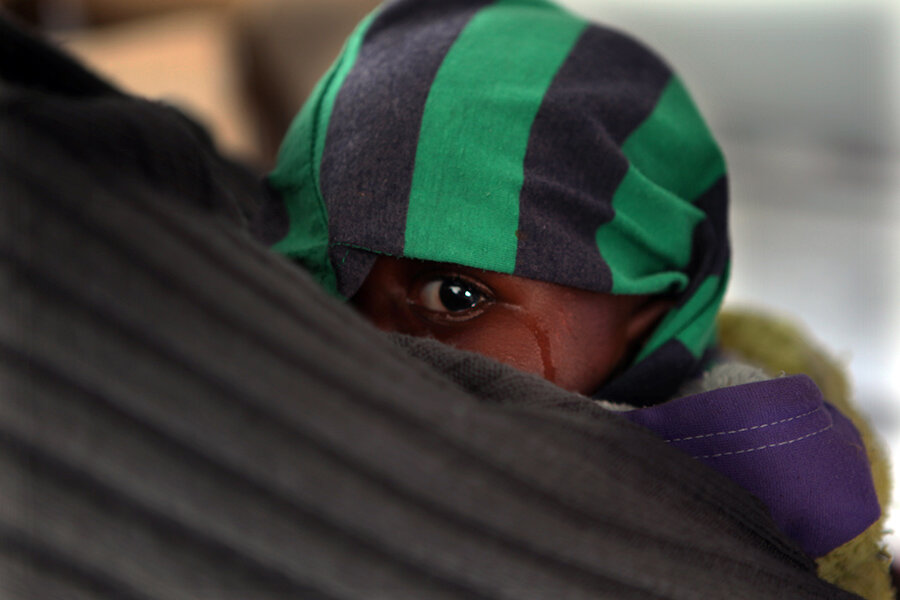Aid to poorest falls: Is world's charity going to those who need it most?
Loading...
| Washington
If your image of foreign aid is money from the world’s wealthiest countries flowing to the poorest, think again.
As it turns out, the share of the world’s pot of foreign aid – itself near an all-time high last year, at about $135 billion – that goes to what experts call the “least-developed countries” (LDCs) is actually shrinking. In 2014 the world’s 48 LDCs, two-thirds of which are in sub-Saharan Africa, received 30 percent of all development assistance.
The United States is a case in point among donor countries: While the US is the world’s largest provider of foreign aid, the share of that assistance going to the poorest countries dropped from 37 percent in 2013 to 32 percent in 2014.
Now an international group of development organizations is calling on major donor countries to reverse the aid trend – and they’re calling on the wealthiest of the wealthy to set a global example.
Led by the ONE Campaign, an international effort fighting extreme poverty and disease, the organizations are calling on the Group of Seven countries to commit to directing half of their development assistance to the world’s poorest countries within a few years.
The G7 is set to hold its annual summit in Bavaria, Germany, on June 7 and 8.
Reaching that 50 percent threshold would mean an additional $26 billion in aid (at 2014 totals) to the poorest countries, development experts say, and that could have a substantial impact in reducing extreme poverty – defined as subsistence on $1.25 a day or less.
“It’s worth flagging that this year overall ... we’ve seen aid to LDCs actually fall globally,” says Eloise Todd, global policy director at the ONE Campaign in Washington. “Something is going really wrong in the way many donors are allocating their aid.”
The share of the world’s development aid going to the world’s poorest countries has been falling since hitting a peak in 2005, according to the Organization for Economic Cooperation and Development (OECD). Yet while the decline is undisputed, the reasons behind it are varied.
One big reason was a shift by donors to debt reduction. Substantial debt relief to Myanmar, also known as Burma, accounted for a major chunk of last year’s fall in global development assistance, according to the OECD. The OECD’s annual global economic report, issued last month, found that wealthy countries were earmarking more of their foreign aid as loans to middle-income countries.
Other reasons cited by development experts: a rise in humanitarian assistance to address crises like those in Syria and parts of Africa, which have spawned the world’s largest displaced and refugee populations in decades, and a shift by some wealthy European countries to addressing development needs and humanitarian crises in their own backyard.
“Some countries may prefer to target their own region, or where they have geopolitical interests,” Ms. Todd says. She notes that some senior officials she’s met with have expressed “surprise” when informed of the sometimes-sharp drop-offs in their countries’ aid to LDCs.
But another crucial reason is many LDCs’ inability to put development dollars to good use – weak “absorptive capacity,” experts say. This is either because of a lack of the infrastructure and institutional development required to get aid to where it needs to go or simply because of corruption.
“The question of corruption is going to be at the forefront of many people’s minds” as the effort proceeds to boost aid to the poorest countries, says Paul O’Brien, vice president for policy and campaigns at Oxfam America in Washington.
In addition to conventional forms of corruption – lining pockets, taking bribes as a gateway to economic activity in a country – there are other growing scourges such as tax evasion and illicit financial flows (out of a country) that also have to be addressed to win back donor confidence, experts say.
Beyond the effort to get a G7 pledge to boost aid to LDCs, the ONE Campaign will also be pressing for aid to the poorest as United Nations members move toward adopting a new set of global “sustainable development goals” in September.
Development experts note that on the receiving end, the poorest countries must commit to doing more to fund basic social services. In particular, governments should formulate plans for directing services and foreign assistance to girls and women, these experts say. Girls’ education and women’s economic opportunities have been increasingly highlighted as key building blocks in constructing a strategy to lift the LDCs.
A critical test of the effort to redirect more aid to the world’s poorest countries will come in July when UN counties meet in Addis Ababa, Ethiopia, to chart a new course for development financing.
With a two-pronged plan of more aid from the wealthy and greater financial input from the poorest countries themselves, “we hope to create a sustainable environment for growth,” Todd says, “so that we may eliminate extreme poverty.”








